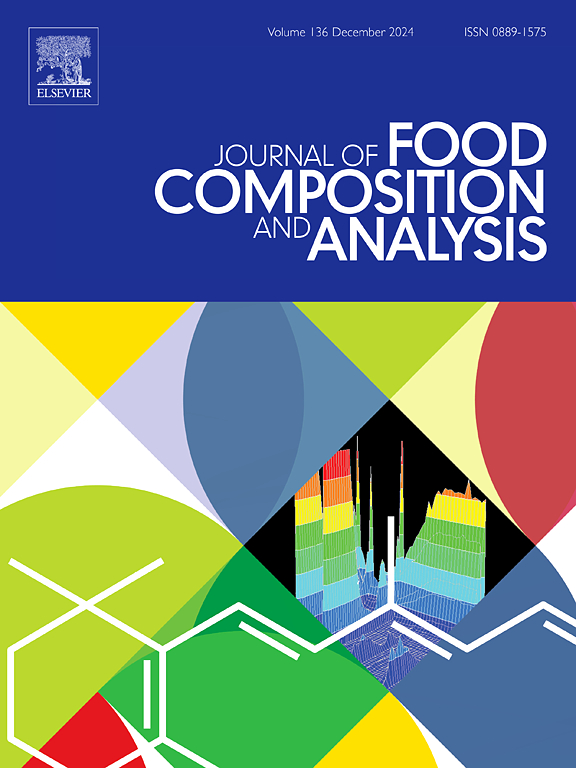采用LC-MS/MS技术监测大豆种子萌发过程中的12种异黄酮
IF 4.6
2区 农林科学
Q2 CHEMISTRY, APPLIED
引用次数: 0
摘要
大豆异黄酮与潜在的心血管保护作用有关。本研究研究了台湾5个大豆品种在萌发过程中异黄酮含量的变化。建立液相色谱-串联质谱(LC-MS/MS)方法,采用Kinetex F5色谱柱和Agilent 6470质谱联用MRM模式,在15 min内定量12种异黄酮。该方法线性良好(3-800 ng/mL, r²>;0.99),灵敏度(LLOQ = 3 ng/mL),精密度(RSD <;13.6 %)。总异黄酮浓度在发芽期逐渐升高,在第4天达到峰值。丙二醇-龙胆素是主要成分,占总异黄酮含量的55 ~ 70 %,从第1天到第4天增加了1.8 ~ 2.5倍。在萌发过程中,糖苷形式也有所增加,而苷元和乙酰糖苷则保持相对不变。这些结果表明,在种子萌发过程中有活性的异黄酮转化,并且第4天可能是收获的有利时间点,以最大限度地提高生物活性异黄酮的产量。该分析方法可为进一步研究豆芽品质及提高功能性化合物积累的工艺优化提供支持。本文章由计算机程序翻译,如有差异,请以英文原文为准。
Monitoring 12 isoflavones during soybean seed germination using LC-MS/MS
Soybean isoflavones have been linked to potential cardiovascular protective effects. This study investigated changes in isoflavone content during germination in five Taiwanese soybean cultivars. A liquid chromatography-tandem mass spectrometry (LC-MS/MS) method was established to quantify 12 individual isoflavones within 15 min, using a Kinetex F5 column and Agilent 6470 mass spectrometer in MRM mode. The method showed good linearity (3–800 ng/mL, r² > 0.99), sensitivity (LLOQ = 3 ng/mL), and precision (RSD < 13.6 %). Total isoflavone concentrations increased progressively during the germination period and peaked on day 4. Malonyl-genistin was the dominant component, contributing 55–70 % of the total isoflavone content, and exhibited a 1.8- to 2.5-fold increase from day 1 to day 4. Glycoside forms also increased during germination, while aglycones and acetyl-glucosides remained relatively constant. These results indicate active isoflavone transformation during germination and suggest that day 4 may be a favorable time point for harvesting to maximize bioactive isoflavone yield. This analytical approach can support future studies on soybean sprout quality and processing optimization aimed at enhancing functional compound accumulation.
求助全文
通过发布文献求助,成功后即可免费获取论文全文。
去求助
来源期刊

Journal of Food Composition and Analysis
工程技术-食品科技
CiteScore
6.20
自引率
11.60%
发文量
601
审稿时长
53 days
期刊介绍:
The Journal of Food Composition and Analysis publishes manuscripts on scientific aspects of data on the chemical composition of human foods, with particular emphasis on actual data on composition of foods; analytical methods; studies on the manipulation, storage, distribution and use of food composition data; and studies on the statistics, use and distribution of such data and data systems. The Journal''s basis is nutrient composition, with increasing emphasis on bioactive non-nutrient and anti-nutrient components. Papers must provide sufficient description of the food samples, analytical methods, quality control procedures and statistical treatments of the data to permit the end users of the food composition data to evaluate the appropriateness of such data in their projects.
The Journal does not publish papers on: microbiological compounds; sensory quality; aromatics/volatiles in food and wine; essential oils; organoleptic characteristics of food; physical properties; or clinical papers and pharmacology-related papers.
 求助内容:
求助内容: 应助结果提醒方式:
应助结果提醒方式:


